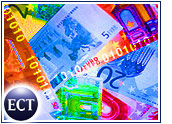
Since the 1970s, Latin American currency markets have been almost synonymous with high risk. But sparked by the spread of free-trade agreements and regional trading blocs — such as the North American Free Trade Agreement (NAFTA), its pending successor the Free Trade Association of the Americas (FTAA) and Mercosur — online trading, investing and speculating in Latin American stock, bond and foreign exchange markets is on a growth trajectory.
The Basel, Switzerland-based Bank for International Settlements (BIS), which oversees world electronic banking payment systems and conducts regular surveys of the global foreign exchange market, estimates that approximately 80 percent of world exchange trading involves the major or “hard” currencies of G7 countries — the U.S. dollar, euro, British pound, Japanese yen and Canadian and Australian dollars. Clearly, the Latin American component of this market is far from dominant, but even 20 percent of a US$1.7 trillion-per-day market translates into $340 billion worth of daily trades in other currencies. And that translates into opportunities for aspiring online foreign exchange trading service and systems providers.
In fact, rapid development of Internet technologies during the past decade, along with liberalization of Latin American economies and financial markets, is leading a growing number of banks, brokerages and new, technology-driven market entrants to view online foreign exchange trading and support as a viable business opportunity, if not a necessity for survival.
Yesterday, Today and Tomorrow
The forerunners of today’s electronic foreign exchange trading systems date back to the early 1980s and were designed essentially as electronic substitutes for phone- and fax-based communications with interdealer brokers, who facilitate large foreign exchange trades anonymously between dealers working for the major foreign exchange banks. As the pace of e-commerce technology development and innovation accelerated and reached more banks and brokers in the United States, that reach also extended to use in overseas markets.
Today, a simple Google search on “online foreign exchange trading” yields more than 210,000 items, although many of them are nothing more than content aggregators seeking to generate revenue by linking to third-party service providers.
There are some basic mechanics of foreign exchange trading that are the same no matter which system you use. Whether you trade foreign exchange online or in a more traditional manner, your order ultimately will be “filled” by a primary market dealer, either in the over-the-counter market (OTC) by a market maker working for a bank or foreign exchange trading company or on a futures exchange, such as the Chicago Mercantile Exchange or Philadelphia Stock Exchange, both of which offer foreign exchange futures and options contracts for a range of currencies, including such Latin American currencies as the Mexican peso.
Toward Centricity
Traditionally, the foreign exchange market has been decentralized, meaning there is no central exchange where market participants can discover a best price for their trades with relative ease. This has been changing, however, with the introduction and spread of e-commerce-based foreign exchange trading systems and with the entrance of new, technology-driven players into the market.
New players are not the only ones using such systems. Large professional investors now are adopting them as well, using them to search across banks, brokers and exchanges for the best prices and to conduct business in a low-cost fashion.
In a U.S. Federal Reserve Bank study, “Foreign exchange markets in the 1990s: Intraday market volatility and the growth of electronic trading,” authors Alain Chaboud and Steven Weinberg found that while accurate, precise estimates of electronic foreign exchange broking systems’ market share are difficult to come by because of the foreign exchange market’s decentralized nature, some general estimates can be arrived at. As stated in the report: “An estimate of the share of inter-dealer trading through electronic platforms puts the share at 5% in 1992, a bit more than 10% in 1995, about 40% in 1998 and about 60% in 2001. These data probably understate the importance of electronic broking in these markets.”
While the growth of electronic foreign exchange broking and trading systems has led to a dramatic reduction in the number of interdealer foreign exchange brokers since the mid-1990s, it also has yielded significant benefits to the market as a whole and to customers in particular, Chaboud and Weinberg found. The report states that “…the process of price discovery and the current price disseminated among dealers and to the public has changed substantially. There is clearly much more price transparency (in terms of): 1) greater clarity and precision of price; 2) most dealers have instant access to current prices; and 3) customers can also gain real-time access to competitive prices from multiple dealers.” The net result, they add, “…has been a clear increase in price competition, and the market power the industry as a whole exerts over its customers appears to have eroded greatly.”
More Changes Ahead
Chicago-based Peregrine Financial Group (PFG) is an example of a group of experienced, formerly “traditional” foreign exchange market brokers, market makers and salespeople who have taken advantage of the rise of e-commerce technology to expand and change the way they do business.
The company is a Futures Commission Merchant (FCM) registered with U.S. industry regulators the Commodity Futures Trading Commission (CFTC) and the National Futures Authority (NFA). In September 2003, it launched version 7.0 of its BESTDirect online foreign exchange trading system.
The motivation for FCMs, banks and other foreign exchange broker-dealers to promote and make use of electronic foreign exchange trading technology is stated simply by Doug Wassendorf, Jr., who is in charge of the company’s foreign exchange division. “Individual traders benefit from the simplicity, speed and efficiency of electronic trading and the ability to make global foreign currency payments at rates formerly enjoyed only by corporate and institutional clients.”
Some 75 percent of the U.S.-based FCM’s growing customer base is located overseas and have been introduced to the company’s BESTDirect trading platform through alliances with overseas brokers in such countries as Mexico, Kuwait and Japan. In addition to trading the world’s major currency pairs, PFG also makes markets for customers in Mexican peso futures and futures options contracts traded on the Chicago Mercantile Exchange.
As a result of its aggressive research and development initiatives and efforts to promote use of its system and services internationally to both large and small investors, PFG has seen the average value of its transactions grow from approximately $100,000 at the dawn of 2003 to more than $20 million by the end of last November.
Fierce Competition
Competition to come up with technological innovations is fierce among online foreign exchange broker-dealers. Last October, after a successful one-week beta test, PFG announced it had become the first FCM to introduce an electronic interface to the Chicago Mercantile Exchange’s iTOPS automated order routing system.
Being the first to build such an interface, which routes customer orders from PFG’s trading desk directly to exchange floor brokers for execution, is a technological feather in the company’s cap as well as an edge — albeit a temporary one — for its customers.
Such technological and service-oriented competition is a big reason why U.S.-based foreign exchange broker-dealers and exchanges have expanded successfully in Latin America and in other, more developed markets around the world, including Europe, the Far East and Canada. Why reinvent the wheel — and spend millions of dollars — when you can license or strike up an alliance with a U.S. broker-dealer that is more than willing to partner with you?
Promise and Peril
However, while the global, foreign exchange market is by far the largest financial market in the world, with average daily transaction volumes of some $1.7 trillion, it is also largely unregulated, translating into greater risks for all market participants, be they online trading service providers or individual investors.
Trading in Latin American currencies poses unique problems and particularly difficult-to-manage risk for online foreign exchange trading and service providers as well as market makers. Depending on the policy of a specific foreign exchange trading firm, investors often can apply significant amounts of leverage, on the order of 50:1 or greater, which essentially multiplies profits or losses by 50 times or more.
In addition, many Latin American nations have suffered severe depreciations of their currencies, runaway inflation and political instability. Such disruptions have led to higher costs for Latin American governments and businesses and a prevailing sense of caution among domestic and foreign investors. Latin American central banks also need to maintain large U.S. dollar accounts to service their debts and intervene in the foreign exchange market to defend and manage their currencies. Such events can lead to capital flight and “spikes,” or peaks, and troughs in trading volumes for banks and brokerages offering foreign exchange services, either online or in traditional fashion.
Making matters worse, in a BIS Working Paper examining foreign exchange market volatility and bid-ask quotation spreads using a set of seven emerging market currencies, including the Brazilian real and Colombian and Mexican pesos, author Gabriele Galati found that volatility and spreads in the Brazilian real and Mexican peso foreign exchange markets, as well as in the market for the South African rand, ran counter to empirical evidence and the common industry-wide assumptions built into dealers’ risk-management models and trading systems.
This finding means that dealers — and all other participants in these markets — consciously or not assume significant risk. If they recognize this fact, they need to determine whether or not the potential rewards are worth managing the risk and whether or not it is worth investing the time and effort to design, test and put into real-world use specific models to manage their market positions.
Caveat Emptor
Whether you are a professional working for a commercial or investment company or an individual investor considering trading currency markets online, a host of options are available, with plenty of opportunities to earn profits or suffer losses. Above all, it is important to remember the caveat “buyer beware” — especially if you intend to trade less liquid, more volatile currencies, such as Latin America’s.
A good reference point from which to dig a bit deeper into the risks and opportunities of trading foreign exchange is the U.S. National Futures Association Web site. Also worthwhile reading is the “FX Market” section of U.S.-based foreign exchange broker-dealer GAIN Capital’s Web site.















































Social Media
See all Social Media